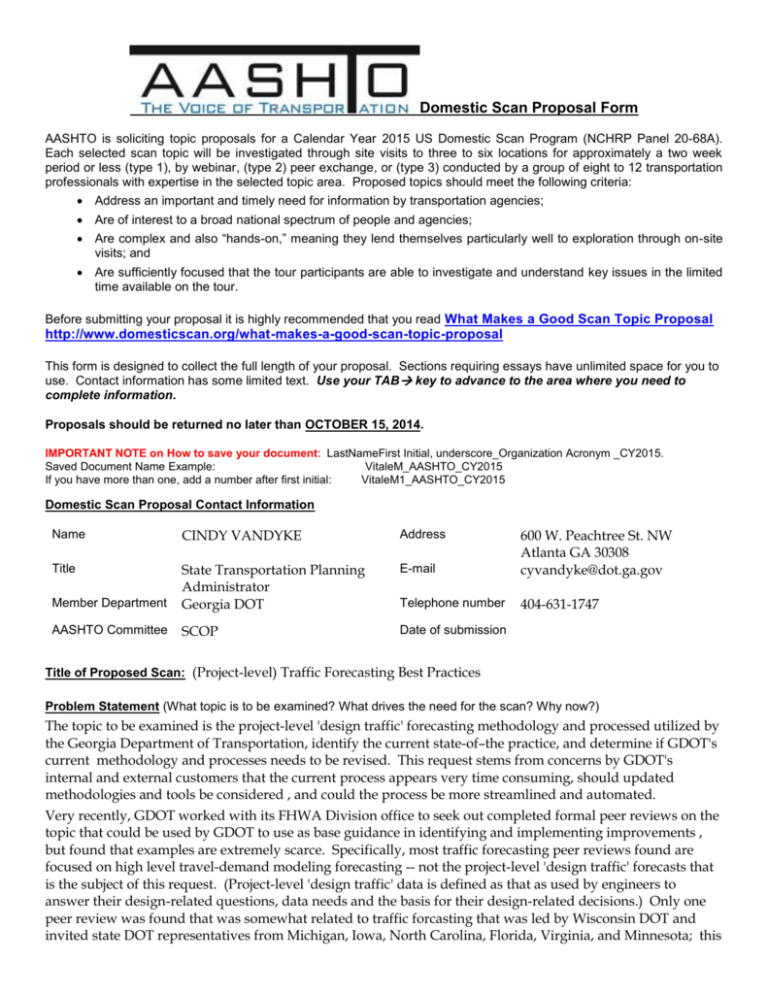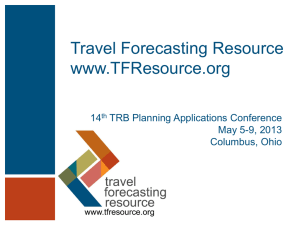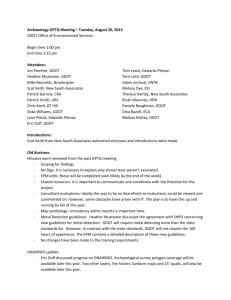vandykec_GDOT_Organization_CY2015
advertisement

Domestic Scan Proposal Form AASHTO is soliciting topic proposals for a Calendar Year 2015 US Domestic Scan Program (NCHRP Panel 20-68A). Each selected scan topic will be investigated through site visits to three to six locations for approximately a two week period or less (type 1), by webinar, (type 2) peer exchange, or (type 3) conducted by a group of eight to 12 transportation professionals with expertise in the selected topic area. Proposed topics should meet the following criteria: Address an important and timely need for information by transportation agencies; Are of interest to a broad national spectrum of people and agencies; Are complex and also “hands-on,” meaning they lend themselves particularly well to exploration through on-site visits; and Are sufficiently focused that the tour participants are able to investigate and understand key issues in the limited time available on the tour. Before submitting your proposal it is highly recommended that you read What Makes a Good Scan Topic Proposal http://www.domesticscan.org/what-makes-a-good-scan-topic-proposal This form is designed to collect the full length of your proposal. Sections requiring essays have unlimited space for you to use. Contact information has some limited text. Use your TAB key to advance to the area where you need to complete information. Proposals should be returned no later than OCTOBER 15, 2014. IMPORTANT NOTE on How to save your document: LastNameFirst Initial, underscore_Organization Acronym _CY2015. Saved Document Name Example: VitaleM_AASHTO_CY2015 If you have more than one, add a number after first initial: VitaleM1_AASHTO_CY2015 Domestic Scan Proposal Contact Information Name CINDY VANDYKE Address Title E-mail Member Department State Transportation Planning Administrator Georgia DOT 600 W. Peachtree St. NW Atlanta GA 30308 cyvandyke@dot.ga.gov Telephone number 404-631-1747 AASHTO Committee SCOP Date of submission Title of Proposed Scan: (Project-level) Traffic Forecasting Best Practices Problem Statement (What topic is to be examined? What drives the need for the scan? Why now?) The topic to be examined is the project-level 'design traffic' forecasting methodology and processed utilized by the Georgia Department of Transportation, identify the current state-of–the practice, and determine if GDOT's current methodology and processes needs to be revised. This request stems from concerns by GDOT's internal and external customers that the current process appears very time consuming, should updated methodologies and tools be considered , and could the process be more streamlined and automated. Very recently, GDOT worked with its FHWA Division office to seek out completed formal peer reviews on the topic that could be used by GDOT to use as base guidance in identifying and implementing improvements , but found that examples are extremely scarce. Specifically, most traffic forecasting peer reviews found are focused on high level travel-demand modeling forecasting -- not the project-level 'design traffic' forecasts that is the subject of this request. (Project-level 'design traffic' data is defined as that as used by engineers to answer their design-related questions, data needs and the basis for their design-related decisions.) Only one peer review was found that was somewhat related to traffic forcasting that was led by Wisconsin DOT and invited state DOT representatives from Michigan, Iowa, North Carolina, Florida, Virginia, and Minnesota; this peer review was held in late May, 2014 and somewhat touched on project level 'design traffic' forecasting issues but, as a TMIP project, focused on the high-level forecasts produced by travel demand models. [FYI: TMIP is FHWA's Travel Model Improvement Program: www.fhwa.dot.gov/planning/tmip/about]. Due to the very recent date of this peer review, no report is publicly available at this time. Scan Scope (What specific subject areas are to be examined? Which cities and states might be visited? Which agencies/organizations (including specific departments or types of staff if applicable)? The specific area to be examined is GDOT's project-level 'design traffic' forecasting methodolgy and processes currently in place. Potential sites to visit are not all known; internal research and discussion with FHWA Division office has not yielded a solid idea of best-practice state DOTs, but we are aware that Florida DOT has a recently-published methodolgy; other best-practice state DOTs would also need to be identified and considered. In addition, the findings of the recently-completed NCHRP 765 will be referenced as an additional resource to provide input on best-practice agencies and methodologies/processes. Anticipated Scan Results (What key information is to be gained? What information is to be shared after the scan? Who would the audience be for this information?) The information that GDOT would like to gain is whether our current project-level 'design traffic' forecasting methodolgies address the needs of traffic forecasting, and is using the most innovative and time-saving processes and techniques that would also improve product accuracy. GDOT would like to determine whether what we are doing is the most efficent and most responsive process and how it could be improved. Questions to be asked could include, but are not limited to, "Are there areas that we could improve upon and provide a better level of customer service/expection, such as reduced delivery time and need for special counts?", "In MPO areas with travel demand models, are there better ways to use those forecasts in the development of the detailed project-level 'design traffic' forecasts?", and "Are there new and/or improved tools available that could assist with this process?" All of the information gained would be shared with other state DOTs as this is a common deliverable for all of them. The audience for this Scan would be state DOTs, and the area of their respective DOT that conducts this level of project-level traffic forecasting. The scan will also utilize the recently-completed NCHRP 765, further validating the work done as part of that important project. Benefits Expected (Including potential impacts on current technology or procedures) We hope to improve our project-level traffic forecasting processes, including accuracy of the product and timesaving techniques. We would like to verifiy those parts of our methodolgy that are acceptable and improve, add, and/or streamline and automate the entire process to make the most of our limited financial and staff resources.









